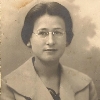|
|
|
Town
history
|

|
by
Dina Kopilov
(nee Kaplun)
|
“ Yalkut
Vohlin” 10 1949
Translated
from Hebrew by Ruth Kally |
|
|
Krasnostav
It was a small
townlet in the district of Zvihil¹ on
the way to Berezdov, five parasangs²
from it. About thirty parasangs from
Koritz on one side and the same distance
from Slavuta on the other. According to
tradition Krasnostav began as a village,
and years later, when the growing Jewish
population brought about the development
of the place, it was recognized as a
townlet.
There is a river
flowing near Krasnostav. According to
the stories of the elders a great battle
was fought over it in the days of the
Polish revolt, and it filled with the
blood of the dead fighters; that's
why the place's name was turned to
Krasnostav (=red river)³. People of the
older generations tell that there was a
Jewish settlement in Korchik, a village
near Krasnostav. It was ruined during
earlier wars, but an ancient cemetery
remained there whose relics were
preserved until quite recently. They
think that the survivors of this village
moved to Krasnostav and settled there.
Only 246 Jews lived
in the townlet in 1847; the number
increased and by1897 there were 1222 of
them, and they formed some 60% of the
population. When the First World War
broke out in 1914, it is estimated that
they numbered about 1500. Almost all
were religious, of the Hassidic sect.
What was the status
of the Jews of Krasnostav? Except few
families that were regarded wealthy, the
majority were hard working people,
artisans, petty grocers and beggars. The
town's Jews were modest and their
manners were simple, just as in most of
the townlets in Vohlin; they earned
their living and maintained themselves.
Social life at the town was tranquil,
almost without any fermentation, if one
doesn't take into account temporary
conflicts between the Gabbai and the
common folk. In most cases, these
conflicts were settled and forgotten.
The younger generation didn't much
differ, and usually followed in the
footsteps of their fathers, at least
until the news of freedom from the
Tsar’s yoke in the spring of 1917. Young
boys and girls then absorbed their
spiritual influence from the nearby
Shepetovka and Slavuta, and at the time
of the Revolution and the political rise
they devoted themselves to the national
idea, and acted for the sake of the
Zionist Movement.
During the transition
period between one regime and another
(1918-1920), when groups of fighters and
various gangs were roaming through The
Ukraine, the Jews suffered severely; in
a number of cases they were assaulted by
shop and house robbers, and in one case
four Jews were killed and thirty one
wounded. Insecurity and economic decline
caused some Jews to leave the place for
other towns or to migrate to America. In
fact, even during 1904-6 there started
migration for financial profits, and a
bridge was created between America and
Krasnostav.
About education: in
the past children were learning in the
"Heider", and at the age of 12-13 they
started training crafts in the workshops
for making a living, as a way of life.
The most outstanding Heider was that of
Rabbi Moshe Idel's, a prominent scholar,
who taught only 6-7 of the best older
boys in the town. Then, in about 1910,
Moshe Krantsberg decided to amend the
state of education, and established a
"Reformed Heider" where he taught Hebrew
in Hebrew. This was a revolutionary
renovation, and there were those in the
town who objected because they looked
upon it as a sabotage against the
religious education. The Reformed Heider
didn't last long and was closed. Then
appeared another man, Baruch Kotic, who
was a scholar, well learned in religious
studies, active in the field of
education, and took care of funds for
education in the town.
An outstanding woman was
Bracha, daughter of Henyah-Leah, the
wife of Nachum Kolker from Olevsk. She
participated in the local public
activities, and was well respected in
all circles. Other distinguished persons
were Rabbi Avraham-Wolf, the melamed
from Tuchin, and Rabbi Yisrael David;
both had Heiders where they taught the
older boys, especially The Talmud. Also
Rabbi Motye Reznik of the Slaughterer's
family, and his sons Feivel and Noah.
Motye's brother, Yochanan, and his sons
Ezra, Hana and Yossi, were all scholars,
and respected in the town.
There were two Rabbis in
Krasnostav. One of them was Rabbi
Simcha, whose wife had a shop; he was
supported by land owners. The second one
was Rabbi Moshe, a young Rabbi who was
invited by the tailors, and lived in
poverty all his life. Rabbi Simcha had a
praying-house of his own. And there was
a large synagogue and another one called
"the small".
After the civil wars in
1920, when the Vohlin district was
divided between Russia and Poland,
Krasnostav remained under the Soviet
reign(The Ukraine), and since then life
has been newly shaped in the Bolshevik
form with all the arrangements of the
new regime. The town was disconnected
from Jewish centers for two decades,
until it was conquered by the Natzi
Germans who destroyed it and
exterminated its Jews.
|
Notes:
1 - Zvihil, today
Novohrad-Volyns'kyi, Zhytomyrs'ka oblast
2 - here 1 parasangs = 1 km
3 - the other version: "Nice
pond"
|
|

